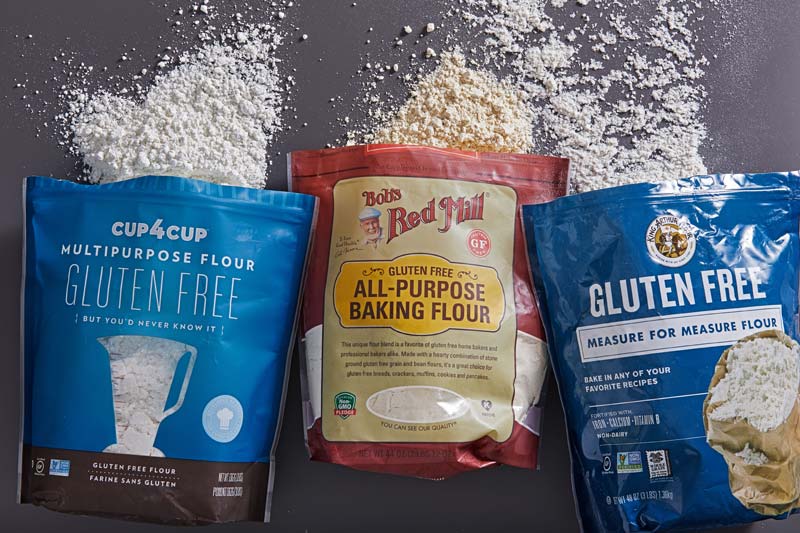 Tom McCorkle for The Washington Post
Tom McCorkle for The Washington Post
It's the kind of conundrum home bakers face when trying to accommodate friends or family who don't eat wheat for medical or lifestyle reasons. Even if a baker is used to working with conventional flour, using a gluten-free blend is an appealing way to be inclusive.
Gluten-free baking used to be "pretty dismal," says Charlotte Rutledge, test kitchen manager at King Arthur Flour. Things have come a long way in just the past decade. "It's sometimes hard to distinguish something that's gluten free versus something with the conventional counterpart."
Here's what to keep in mind if you're baking with gluten-free flour blends, particularly with a recipe originally designed for all-purpose flour.
• Understand how they work and what's in them. While recipes with wheat get their chew and structure from gluten, which is formed when proteins in the flour interact with water, gluten-free flours rely on the starches from alternative grains. When those starches are combined with water, they provide structure as well. Typical grocery store blends feature white or brown rice flour and sorghum flour, as well as starches such as potato or tapioca. You can, of course, make a blend at home to use in a variety of recipes, though I'd recommend following a recipe from a reputable source before attempting it. Or you can follow the lead of Jeffrey Larsen, whose recent book, "Gluten-Free Baking at Home," offers customized blends for each recipe to ensure the best results.
One thing to note: Several brands, including King Arthur Flour and Bob's Red Mill, offer two versions of gluten-free blends. If you're looking for something that can be substituted directly for all-purpose flour, look for those labeled as one-to-one or measure-for-measure. (Cup4Cup is another widely available brand.) These formulations include xanthan gum, which Rutledge says serves as a stabilizer and emulsifier to help with structure. If you pick up a gluten-free blend labeled as all-purpose, check the instructions or your recipe, because you may need to add something like xanthan or guar gum.
• Know where they work best. "Pastry is probably the broad category of things that generally lend themselves well to gluten-free baking," Rutledge says. By that, she means such treats as cookies, pie crusts, muffins and scones, which are generally not intended to have much chewy structure anyway. If you've ever been warned not to overmix baked goods made with wheat flour, that's less of a concern here. "The upside of gluten-free pies and tarts is that you really can't toughen the dough. There is no gluten to overwork!" writes Larsen. The same goes for cakes, muffins and quick breads.
• Be prepared to adjust. Ideally, a recipe using measure-for-measure flour won't require you to change too much else. In some cakes, Rutledge says, you may find you need to hydrate with something that will provide you with more structure, such as an egg. Flaxseed can help with this, too, when combined with water (for one flaxseed "egg," combine 1 tablespoon flaxseed meal with 3 tablespoons of water and let rest for 10 or 15 minutes). Avoid using more fat, such as oil or butter, which can further weigh down the batter.
If your recipe calls for something like pieces of fruit or grated vegetables, be extra vigilant about draining as much moisture as you can to avoid dense or even raw dough. "Reducing the amount of moisture is absolutely crucial in gluten-free baking. Regular baking is so much more forgiving," Larsen says. "The gluten strands that are formed during mixing can hold a great deal of moisture both in terms of oil and liquid. In gluten-free baking you have to be really precise." You can even decide to forgo the risk by using a fruit glaze on top of the finished treat rather than adding fruit to the dough itself.
Larsen offers a few more pointers. He typically prefers baking cakes in 7- or 8-inch pans, as he finds that gluten-free doughs and batters need an assist in gaining height. If you're rolling out gluten-free cookies, keep the pin well-floured so it doesn't stick. He says gluten-free goods also tend to stick more to bakeware, so grease thoroughly. Know that pie or tart dough will be especially fragile and crumbly, which is why he likes to let it sit overnight in the fridge to allow the liquids to fully absorb. This will make the dough more pliable and less likely to fall apart.
For cookies, Larsen borrowed a technique from cake baking and likes to cream the butter and sugar first and then gradually add the eggs one at a time. "The creaming method ensures that all ingredients are well combined and suspended in the fat and sugar," he says. "It also guarantees that you will have nice tight cookies that will be less likely to spread out over the cookie sheet when baking." The end result: A crisp exterior balanced by a tender airy interior.
As with regular baking, it's always best to be precise by weighing your ingredients.
• Start gradually. Naturally, the trickiest gluten-free endeavor is yeasted bread, so if you're just starting to dabble in gluten-free baking, it's best to work your way up to it after you've become familiar working with wheat-free doughs and batters. "There's kind of this hierarchy of skill level," Rutledge says. But with practice and these tips, you'll get there.
Sign up for the daily JWR update. It's free. Just click here.
(COMMENT, BELOW)


 Contact The Editor
Contact The Editor
 Articles By This Author
Articles By This Author